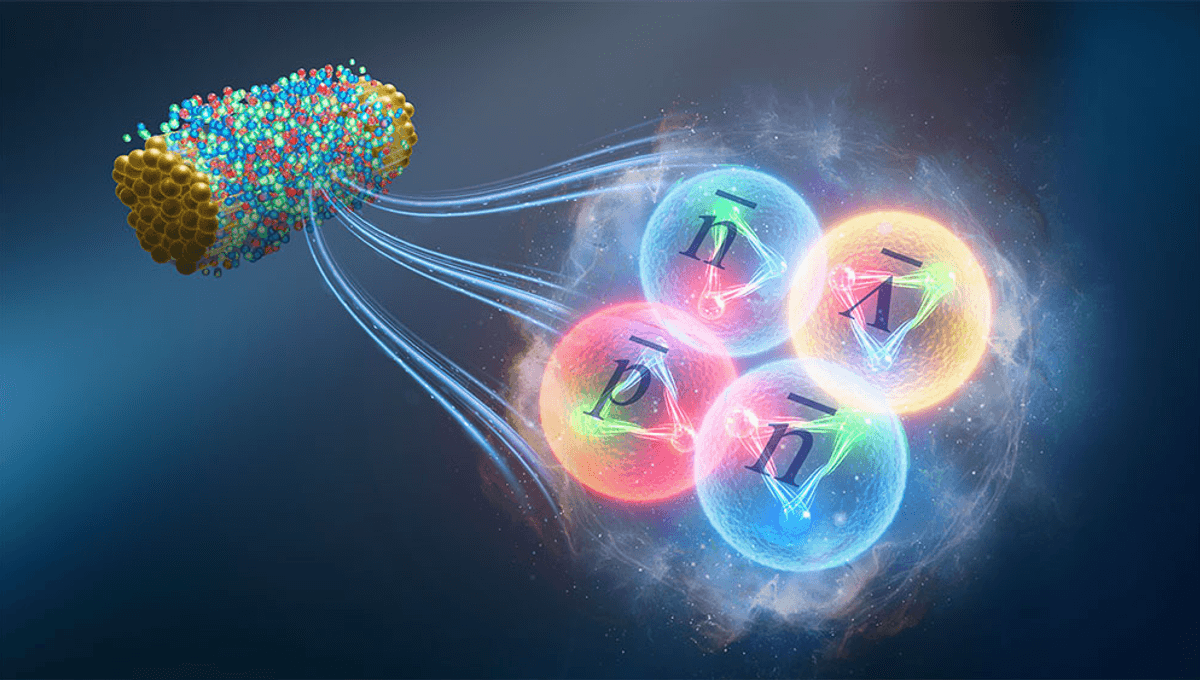
Scientists at the Relativistic Heavy Ion Collider have discovered the heaviest atomic nucleus of antimatter ever found, and it’s a weird one. Even its matter counterpart is weird as it contains a particle made of a strange quark. But before we get into all that weirdness let’s share the name of this new peculiar particle: antihyperhydrogen-4.
The particles at the center of atomic nuclei are usually protons and neutrons. These are made of quarks. Specifically, they are made of up quarks and down quarks. A proton is made of two up quarks and one down, a neutron has two down and one up. But there are four other types of quarks in nature, although some of them can only exist briefly and form at very high energy. All of these quarks have antiquarks, the same mass but an opposite electric charge.
One of these heavier quarks is called the strange quark and can be used to make a variety of particles that are classed under the broad terms of hyperons. The Relativistic Heavy Ion Collider smashes atoms together to recreate the conditions from the first instants after the Big Bang and hopefully help researchers understand one of the biggest puzzles in physics: why the universe became dominated by matter and not antimatter. Each collision produces new particles and members of the STAR Collaboration analyzed 6 billion particle collisions to identify this new antimatter atomic nucleus.
“Our physics knowledge about matter and antimatter is that, except for having opposite electric charges, antimatter has the same properties as matter — same mass, same lifetime before decaying, and same interactions,” STAR collaborator Junlin Wu, a graduate student at the Joint Department for Nuclear Physics, Lanzhou University and Institute of Modern Physics (IMP), China, said in a statement. “Why our universe is dominated by matter is still a question, and we don’t know the full answer.”
“To study the matter-antimatter asymmetry, the first step is to discover new antimatter particles,” said STAR physicist Hao Qiu, Wu’s advisor at IMP. “That’s the basic logic behind this study.”
So, to antihyperhydrogen-4. This atomic nucleus is made of one antiproton, two antineutrons, and one antilambda (the specific antihyperon). The experiment has previously produced antihelium-4, which is made of two antiprotons and two antineutrons and is slightly lighter than the antihyperhydrogen.
“It is only by chance that you have these four constituent particles emerge from the RHIC collisions close enough together that they can combine to form this antihypernucleus,” said Brookhaven Lab physicist Lijuan Ruan, one of two co-spokespersons for the STAR Collaboration.
Crucial to this discovery is the team’s previous experience with antihelium. Antihyperhydrogen-4 actually decays into antihelium-4 and a pion (a particle made of a quark and antiquark). The team looked at the tracks of the particles of antihelium and positive pions and if they started at the same point, they were likely the product of an antihyperhydrogen-4 decaying. They found 16 events that are likely to be the actual antimatter particles.
Analysis of their properties didn’t show any immediate violation of the symmetry of the universe, so we have not been handed the solution of why it is made of matter instead of antimatter. We know that there must be a difference between matter and antimatter. If there wasn’t, we wouldn’t be here because all the matter and antimatter would have annihilated and turned into pure energy.
So where is this difference? Particles interact in specific ways which are underpinned by the laws of physics. These laws respect certain laws of symmetry and scientists look there for violations. Is antimatter behaving in ways that would make it less likely to survive compared to matter? Or has it got properties that don’t match the theory? So far we have seen hints, but nothing concrete. Finding heavier particles is important because they could make it easier to see the potential variations.
The study is published in the journal Nature.
Source Link: New Heaviest Antimatter Atomic Nucleus Discovered Yet